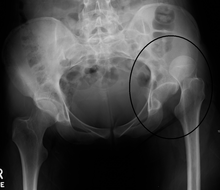| Dislocation of hip | |
|---|---|
 | |
| X-ray showing a joint dislocation of the left hip. | |
| Specialty | Orthopedics |
| Symptoms | Hip pain, trouble moving the hip[1] |
| Complications | Avascular necrosis of the hip, arthritis[1] |
| Types | Anterior, posterior[1] |
| Causes | Trauma,[1] hip dysplasia |
| Diagnostic method | Confirmed by X-rays[2] |
| Differential diagnosis | Hip fracture, hip dysplasia[3] |
| Prevention | Seat-belts[1] |
| Treatment | Reduction of the hip carried out under procedural sedation[1] |
| Prognosis | Variable[4] |
A hip dislocation is when the thighbone (femur) separates from the hip bone (pelvis).[1] Specifically it is when the ball–shaped head of the femur (femoral head) separates from its cup–shaped socket in the hip bone, known as the acetabulum.[1] The joint of the femur and pelvis (hip joint) is very stable, secured by both bony and soft-tissue constraints.[1][4][5] With that, dislocation would require significant force which typically results from significant trauma such as from a motor vehicle collision or from a fall from elevation.[1] Hip dislocations can also occur following a hip replacement or from a developmental abnormality known as hip dysplasia.[6]
Hip dislocations are classified by fracture association and by the positioning of the dislocated femoral head.[7][8] A posteriorly positioned head is the most common dislocation type.[5] Hip dislocations are a medical emergency, requiring prompt placement of the femoral head back into the acetabulum (reduction).[9] This reduction of the femoral head back into the hip socket is typically done under sedation and without surgery, through maneuvers including traction on the thighbone in line with the dislocation.[9] If this is unsuccessful or if there is an associated fracture in need of repair, surgery is required.[10] It often takes 2–3 months for a dislocated hip to fully heal, and it can take even longer depending on associated injuries such as fracture.[11]
Typically, people with hip dislocations present with severe pain and an inability to move the affected leg.[1][4] Diagnosis is made by physical exam and plain X-rays of the hips. A CT scan is recommended following reduction to rule out complications. Complications include osteonecrosis, femoral head fractures, and posttraumatic osteoarthritis.[12][13]
Males are affected more often than females.[3] Traumatic dislocations occurs most commonly in those 16 to 40 years old.[4] Half of all hip dislocations are accompanied by a fracture.[4] The condition was first described in the medical press in the early 1800s.[14][15]
- ^ a b c d e f g h i j k "Hip Dislocation". AAOS. June 2014. Retrieved 7 June 2018.
- ^ Beebe MJ, Bauer JM, Mir HR (July 2016). "Treatment of Hip Dislocations and Associated Injuries: Current State of Care". The Orthopedic Clinics of North America. 47 (3): 527–49. doi:10.1016/j.ocl.2016.02.002. PMID 27241377.
- ^ a b Blankenbaker DG, Davis KW (2016). Diagnostic Imaging: Musculoskeletal Trauma E-Book. Elsevier Health Sciences. p. 495. ISBN 9780323442954.
- ^ a b c d e Egol Kenneth A, Koval KJ, Zuckerman JD (2010). Handbook of fractures (4th ed.). Philadelphia: Wolters Kluwer Health. p. Chapter 27. ISBN 978-1605477602.
{{cite book}}: CS1 maint: multiple names: authors list (link) - ^ a b "Hip Dislocation - Trauma - Orthobullets". www.orthobullets.com. Retrieved 17 March 2021.
- ^ Callaghan JJ, Rosenberg AG, Rubash HE (2007). The Adult Hip. Lippincott Williams & Wilkins. p. 1032. ISBN 9780781750929.
- ^ Cite error: The named reference
:4was invoked but never defined (see the help page). - ^ Cite error: The named reference
:3was invoked but never defined (see the help page). - ^ a b Foulk, David M.; Mullis, Brian H. (April 2010). "Hip Dislocation: Evaluation and Management". American Academy of Orthopaedic Surgeon. 18 (4): 199–209. doi:10.5435/00124635-201004000-00003. ISSN 1067-151X. PMID 20357229. S2CID 24913294.
- ^ "Recovering from Hip Dislocation". Colorado Center of Orthopaedic Excellence. 2 March 2018. Retrieved 23 March 2021.
- ^ Publishing, Harvard Health (17 May 2019). "Traumatic Dislocation of the Hip". Harvard Health. Retrieved 23 March 2021.
- ^ Masiewicz, Spencer; Mabrouk, Ahmed; Johnson, Dean E. (2021), "Posterior Hip Dislocation", StatPearls, Treasure Island (FL): StatPearls Publishing, PMID 29083669, retrieved 17 March 2021
- ^ Graber, Matthew; Marino, Dominic V.; Johnson, Dean E. (2021), "Anterior Hip Dislocation", StatPearls, Treasure Island (FL): StatPearls Publishing, PMID 29939591, retrieved 17 March 2021
- ^ Beebe, Michael J.; Bauer, Jennifer M.; Mir, Hassan R. (July 2016). "Treatment of Hip Dislocations and Associated Injuries". Orthopedic Clinics of North America. 47 (3): 527–549. doi:10.1016/j.ocl.2016.02.002. ISSN 0030-5898. PMID 27241377.
- ^ Yeatman, John C. (June 1815). "Case of Injury of the Hip Confounded with Dislocation, and Fracture of the Neck of the Thigh-Bone". The London Medical and Physical Journal. 33 (196): 469–471. ISSN 0267-0259. PMC 5581659. PMID 30493665.